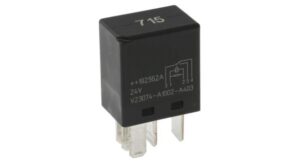What Is Electronic Relay?

A relay controlled by electronic signals is called an electronic relay. It regulates high-current or high-voltage circuits. Electronic relays find usage in many different fields, including transportation, computing, communications, and control.
Table of Contents
What is the Function of an Electronic Relay?
Relays are electrically operated switches that can be employed on their own or as part of a larger control system to regulate the operation of a circuit. An electromagnet, which is activated when a current flows through its coil, is typically responsible for operating the switch. Several different appliances, such as motors, lights, and solenoids, can be managed by the relay. Electromagnets are used in relays, which are switches, to open and close the circuit. A little electric current triggers the electromagnet, which in turn triggers the relay switch. A push button, a switch, or a sensor may be used to activate the switch.
A relay is a device that opens and closes a circuit in response to external signals. A relay, for instance, can be used to regulate the power going to a set of lights. The relay closes the circuit when the light switch is activated, causing the light to come on. If you flip the light switch off, the relay will open the circuit, and the light will go out. Lights, motors, and solenoids are just a few of the many electrical devices that can be controlled by relays. To see, just click here https://sg.rs-online.com/web/c/relays-signal-conditioning/.
Three Distinct Relay Types of Electronics
An electronic relay is a switch that is powered by electricity. A control system is involved, and there are both inputs and outputs. Power for the control system might come from either a direct current (DC) voltage or an alternating current (AC). Control systems typically accept either direct current (DC) or alternating current (AC) signals at their inputs. The control system can provide either an alternating current (AC) or direct current (DC) output.

AC Relays
An alternating current (AC) relay is an electromagnetic device that can disconnect or reconnect an AC load. It is made up of a coil wound around an iron core and a switch that is set off by the coil’s movement. The magnetic field created by the coil is what opens and closes the switch when an alternating current is applied to it. The AC relay can isolate an AC circuit or load, or connect or disconnect an AC load.
Direct Current Relays
An electromagnetic switch that responds to direct current is known as a direct current relay. Its primary function is to regulate power systems. Turning a circuit on or off is as simple as using a direct current relay. Additionally, it can regulate the flow of electricity. Electromagnet-operated switches and relays are two types of such devices. An electromagnet can either open or close a circuit depending on whether or not the magnetic field it generates is strong enough. The electromagnet in direct current relays (DCRs) is powered by direct current. DCRs find employment in a wide range of industries and products, from cars to factories to smartphones.
Delay Mechanisms
Businesses can employ delay mechanisms, which are established in law, to delay or prohibit the disclosure of information. Their primary functions are to safeguard proprietary information, limit legal exposure, and forestall potentially detrimental disclosures. Pre-disclosure agreements, post-disclosure agreements, and protective orders are all examples of delay devices.




